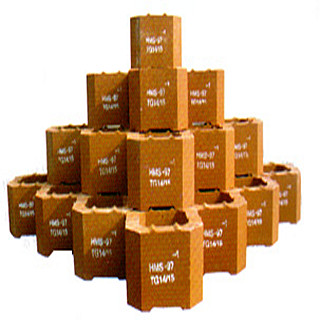Magnesia-carbon bricks are made of high melting point alkaline oxide magnesia (melting point 2800°C) and high melting point carbon materials that are difficult to be infiltrated by slag as raw materials, and various non-oxide additives are added. A non-charcoal composite refractory material combined with a carbon binder. Magnesia-carbon bricks are mainly used for the lining of converters, AC electric arc furnaces, DC electric arc furnaces, and the slag line of ladle. magnesia chrome brick
As a composite refractory material, magnesia-carbon brick effectively utilizes the strong slag erosion resistance of magnesia and the high thermal conductivity and low expansion of carbon, which compensates for the biggest disadvantage of poor spalling resistance of magnesia.
Its main features are: 1. Good high temperature resistance 2. Strong slag resistance 3. Good thermal shock resistance 4. Low high temperature creep

Influence of raw materials on properties of magnesia-carbon bricks
The main raw materials for the production of magnesia-carbon bricks, the quality of magnesia has an extremely important influence on the performance of magnesia-carbon bricks, and how to reasonably select magnesia is the key to the production of magnesia-carbon bricks. There are fused magnesia and sintered magnesia, which have different characteristics. Fused magnesia: large grains, few impurities, few silicate phases, high degree of direct bonding of grains, and few grain boundaries.
magnesia chrome brick
Sintered magnesia: The grains are small, the impurities and silicate are relatively large, and the degree of direct bonding is poor.
For magnesia raw materials, in addition to chemical composition, high density and large crystals are also required in terms of organizational structure. Therefore, as the quality index of magnesia raw materials for producing magnesia-carbon bricks, the following contents should be investigated 1. Magnesium oxide content (purity) 2 The types of impurities, especially the content of C/S and B2O3, the density, pore diameter, and pore morphology of magnesia (sinterability).
The purity of magnesia has a significant impact on the slag resistance of magnesia-carbon bricks. The higher the magnesium oxide content, the less impurities, the lower the degree of silicate phase separation, the higher the degree of direct bonding of periclase, and the higher the ability to resist slag penetration and slag melting loss. The juice in magnesia is mainly calcium oxide, silicon dioxide, iron oxide, [1] if the impurity content is high, especially the compound of boron oxide, it will adversely affect the refractoriness and high temperature performance of magnesia.
The impurities in magnesia mainly have the following influences: 1. Reducing the degree of direct bonding of periclase 2. Forming low-melting substances with magnesia at high temperature 3. Impurities such as iron oxide and silicon dioxide at 1500-1800 ℃, first Magnesium oxide reacts with carbon, leaving pores and making the slag resistance of the product worse.
For magnesia raw materials, in addition to the total amount of impurities, the type and relative content of impurities also have a significant impact on the performance of magnesia. Among them, the effect of CaO/SiO2 ratio and B2O3 content is obvious. Generally, magnesia refractories usually require CaO/SiO2≥2 to improve the high temperature stability of magnesia-carbon bricks.
The carbon material for preparing magnesia-carbon bricks is mainly flake graphite